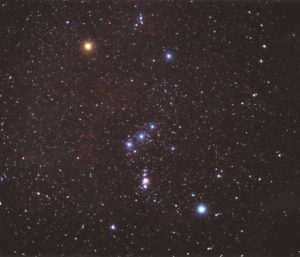Winter begins on Dec. 21, the winter solstice and longest night of the year. It’s the season to chase away the darkness with candles, holiday lights, and gatherings around the fire with friends and family. And this month three bright planets adorn the night sky like colorful ornaments.
Step outside after dark and begin by looking high in the east. There you’ll see Mars shining bright red. Mars reached opposition on Dec. 8, which means it’s at its biggest and brightest and will continue to dazzle through the end of the year.
Next, shift your gaze to the south. The very bright golden-white star that you see is not a star — it’s Jupiter. Jupiter reached opposition in September, but it still outshines everything in the sky except the Moon. (Venus, the brightest planet of them all, is currently hiding behind the Sun.)
Finally, turn to the west and look low. Saturn is a reddish-gold star sinking towards the horizon. It’s dimmer than Mars and Jupiter (Saturn’s opposition was back in August). If you have trouble identifying it, trace a line with your mind’s eye from Mars through Jupiter and continue the arc until you strike a star low in the south. That’s Saturn.

Colors in the night sky are subtle, despite my descriptions of objects as “bright red” or “golden-white.” Our eyes have two different types of photoreceptor cells: rods and cones. Cone cells enable us to perceive a range of colors but react only to bright light; in low-light conditions, they don’t activate. The rod cells are much more sensitive and enable us to see when it’s dark. But the trade-off is that rod cells respond only to a narrow range of wavelengths, especially blue-green, and don’t react to orange and red light at all. This is why our world at night is a monochromatic blue green.
Most stars are too faint to trigger our cone cells. But if you give your eyes a chance to dark-adapt — which means that your pupils dilate, allowing in as much light as possible — and the sky is reasonably clear, you’ll see that some stars and the bright planets do exhibit distinct colors.
We’ve already pinpointed red Mars, golden Jupiter, and orange Saturn. To find some other colorful winter stars, start near Mars. Do you see a star close to Mars that’s a similar red color, but a little dimmer? That’s Aldebaran, the eye of the bull in the constellation Taurus. The name comes to us from Arabic and means “the follower.” The origins of this name are lost. Some historians of astronomy speculate Aldebaran got its name because it appears to follow the Pleiades, a nearby open cluster of stars.
There’s another colorful gem near Mars. Look further up and towards the north. You’ll see a bright yellow star, quite distinct from the red of Mars and Aldebaran. That’s Capella. Besides being pretty, Capella is a very curious star. To our eyes it appears as a single bright star. But it’s actually a quadruple star system. A telescope reveals a pair of binary star systems (two stars that orbit each other); the two binaries in turn orbit each other around a common center of gravity. The fictional solar system of the show Battlestar Galactica is a similar quadruple system.
If you’ve stayed outside long enough to find these planets and stars, you can probably see Orion rising in the east. The Hunter hosts two of the brightest and most colorful stars. Betelgeuse is the red star that marks Orion’s right shoulder. And blue-white Rigel shines at Orion’s left foot. (You can read about the constellation Orion in the Jan. 26, 2022 issue of the Independent and about Betelgeuse in the Feb. 20, 2020 issue.)
Like so many winter traditions, these lights of the night sky are best shared with others. Take someone outside and show them, and may the stars brighten your winter solstice. Clear skies!



